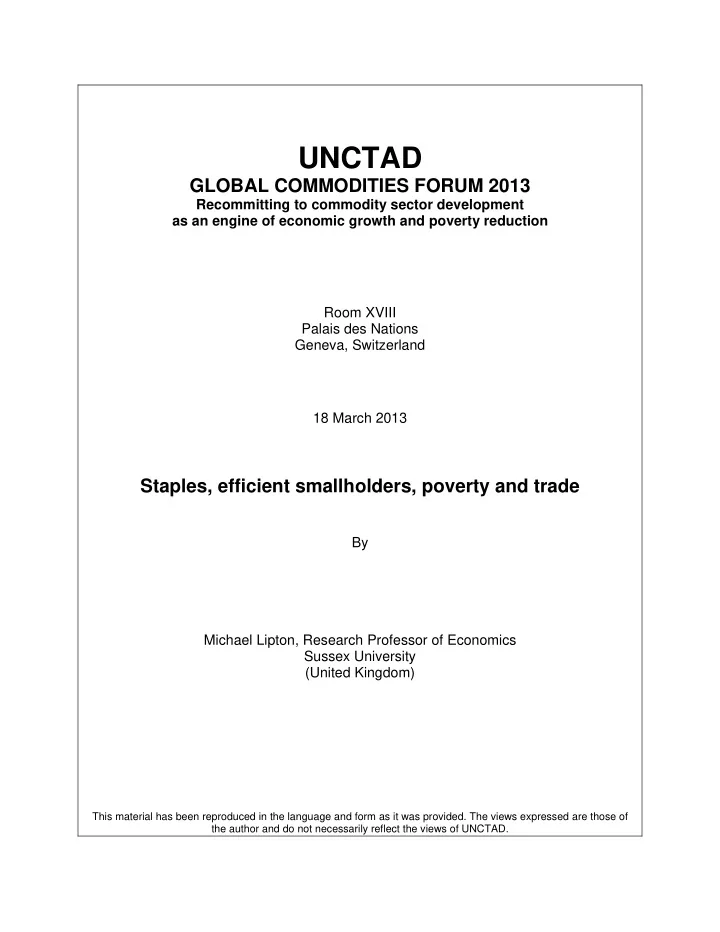

UNCTAD GLOBAL COMMODITIES FORUM 2013 Recommitting to commodity sector development as an engine of economic growth and poverty reduction Room XVIII Palais des Nations Geneva, Switzerland 18 March 2013 Staples, efficient smallholders, poverty and trade By Michael Lipton, Research Professor of Economics Sussex University (United Kingdom) This material has been reproduced in the language and form as it was provided. The views expressed are those of the author and do not necessarily reflect the views of UNCTAD.
1 Staples production: efficient 'subsistence' smallholders are key to poverty reduction, development, and trade Michael Lipton, Research Professor of Economics, Sussex University. Brighton, England UNCTAD Global Commodities Forum, Palais des Nations, Geneva, 18-19 March, 2013 A. Introduction Globally, about a billion people eat far too much. About another billion eat far too little. Mass death, disease and misery are caused both by nutrient deficiency and by nutrient excess. 1 Yet far too little food is transferred from the overfed to the underfed by trade, migration or financial transfers, as they affect food consumption and/or the use of land and other farm resources. That is the greatest failure of economics in the world today. It is only partly the result of poverty and inequality. It is not substantially the result of "market failure". It is, in part, the result of market success , combined with human failure to manage incentives, institutions (including those of control over land), information, and technical progress. In particular, we need much better policies to make incentives, institu- tions and public goods, affecting production and trade in food staples, favourable to low-income, family-based smallholders and, in particular, to "subsistence farmers . Subsistence farmers are smallholders. They usually rely mainly or wholly on family labour. They grow mainly staple foods, in amounts at best sufficient to feed their families - or, in most cases (sub-subsistence or (food) defi- cit farmers ), less than sufficient. Food deficit farm families grow mainly food for home consumption, but need more food than they grow. They buy in the difference with income from selling non-food farm products, hired labour, or products of small non-farm enterprise. "Subsistence farming" has become a term of low abuse. Most writing about farms, especially African farms, as- sumes (a) a stark contrast between subsistence and commercial farms, (b) inefficiency of subsistence farms and (c) the need for a rapid shift from subsistence to commercial farms - and sometimes from small to large farms - for successful development. Yet, as almost all agricultural economists (but few macro-economists?) know, the three assumptions are dead wrong logically, economically, historically and in political practice. 2 Logically, subsistence farms, even deficit farms, can be commercial. They can and do obtain cash in several ways (see below), including sale of farm output. They are substantial buyers and users of farm inputs. Economically - where savings are scarce, and rural labour still plentiful and increasing - such farms are more socially efficient than large farms. That's not because their production costs, per unit of output or of land, are very different. It's because small farms, with small areas and mainly family workers, enjoy lower unit transac- tion cost in managing labour. Thus small subsistence farms, including deficit farms, normally produce more per unit of scarce land and water, with less use of scarce capital, and more employment. And they are innovative as big farmers: in many studies small farms actually use more fertilizer per hectare. Historically, Asia's take-off since 1965, into rapid growth with massive poverty reduction,- is based on a green revolution in food staples output, mainly on subsistence and near-subsistence smallholdings. (Arguably the same was true of much of Europe in the nineteenth century.) Combining the history and the economics, in a big majority of countries in Asia, Africa and Latin America with decennial agricultural censuses, proportions of farmland in small farms have risen - reflecting their efficiency and ability to innovate. In political practice, labour forces in Africa (and parts of Asia) will grow at over 2%/year for decades. These people won't escape poverty without extra demand for labour and/or cheaper locally available food staples. De- spite urbanization, neither will happen without sustained growth of farm output, especially staples, on subsist- 1 In 2008, some 1·5bn adults were overweight (BMI ≥25 kg/m 2), including 500mn who were obese (BMI ≥30 kg/m 2): M. Finucane, G. Stevens, M. Cowan, G. Danaei, J. Lin, C. Paciorek, G. Singh, H. Gutierrez, Y. Lu, A. Bahalim, F. Farzadfar, L. Riley and M. Ezzati, 'National, regional, and global trends in body-mass index since 1980', Lancet 2011 Feb 12:377(9765):557-67. In 2011, about 310mn under-fives were mildly, moderately, or severely stunted and about 260mn - plus hundreds of millions of over-fives - were mildly, moderately, or severely underweight: G. Stevens, M. Finucane, C. Paciorek, S. Flaxman, R. White, A. Donner and M. Ezzati, 'Trends in mild, moderate, and severe stunting and underweight, and progress towards MDG 1 in 141 developing countries: a systematic analysis of population representative data', Lancet, 2012 Sep 1:380(9840): 824 – 834. 'Mild, moderate and severe' mean, respectively, 1, 2 or 3 standard deviations below the NCHS norm. 2 See below & M.Lipton, Land Reform in Developing Countries: property rights and property wrongs, London: Routledge 2009; R. Eastwood, M, Lipton & A. Newell 2010, 'Farm size', in Handbook of Agricultural Economics, 4: Agricultural Development: Farm Policies & Regional Development: 3323-94.
Recommend
More recommend